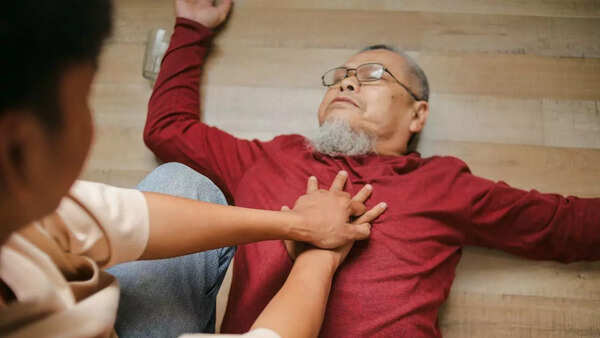Understanding Cardiac Arrest: Causes, symptoms, survival, and how it differs from a heart attack |

Cardiac arrest is a sudden and often fatal condition that occurs when the heart abruptly stops beating due to a disruption in its electrical signals. This immediately halts blood flow to the brain and other organs. According to Medical News Today, without immediate medical intervention, death can occur within minutes. The survival rate for out-of-hospital cardiac arrest is roughly 10%, though this can double or even triple with early bystander CPR and defibrillation, as confirmed by the American Heart Association (AHA).Inside a hospital setting, where trained professionals and equipment are readily available, the survival rate increases to around 25%. Newer interventions like extracorporeal membrane oxygenation (ECMO) are also emerging in specialised centres to improve outcomes for certain patients. In this article, we explore the causes of cardiac arrest, how it differs from a heart attack, signs to watch for, and the importance of timely action and prevention.
What actually happens in cardiac arrest
Cardiac arrest typically starts with a malfunction in the heart’s electrical system. This may result in ventricular fibrillation (chaotic, ineffective contractions) or asystole (complete lack of electrical activity). As blood stops circulating, individuals collapse suddenly, lose consciousness, and have no detectable pulse. The American Red Cross notes that for every minute without CPR or defibrillation, survival chances drop by about 7% to 10%.In hospital settings, doctors may detect pulseless electrical activity (PEA)—a condition where the heart shows electrical signals but does not pump blood. Out-of-hospital PEA has one of the lowest survival rates, estimated at just 2–5%, even with emergency care.
Cardiac arrest causes and risk factors
Several factors can trigger cardiac arrest:
- Coronary artery disease (CAD) – AHA statistics indicate that up to 80% of sudden cardiac arrests are linked to CAD, where narrowed arteries compromise heart function.
- Arrhythmias, especially ventricular tachycardia or ventricular fibrillation.
- Cardiomyopathies (weakened heart muscle) and congenital heart defects.
- Acute events, such as choking, trauma, massive bleeding, or sepsis.
- Electrolyte imbalances, such as abnormal potassium or magnesium levels.
- Drug overdose or certain medications that affect heart rhythm.
Cardiac arrest symptoms
Cardiac arrest is often sudden, but some early indicators may occur days or weeks in advance. These include fainting, chest discomfort, racing heartbeats, nausea, or unexplained fatigue. These symptoms are frequently dismissed, especially in older adults. At the time of arrest, typical signs include:
- Chest pain or discomfort
- Palpitations or rapid heartbeat
- Lightheadedness or fainting
- Shortness of breath
- Extreme fatigue or weakness
Cardiac Arrest vs. Heart Attack
These two conditions are often confused, but are very different:
- A heart attack is a circulation issue, where blood flow to the heart muscle is blocked. Symptoms may appear gradually, such as chest pain, and medical treatment is often possible if caught early.
- A cardiac arrest is an electrical malfunction that causes the heart to stop suddenly and completely. Without immediate action, it usually results in death.
While a heart attack can lead to cardiac arrest, the two are not the same and must be treated differently.
The crucial role of CPR and defibrillation in cardiac arrest
The American Heart Association reports that only 40–45% of out-of-hospital cardiac arrests receive bystander CPR, despite its life-saving potential. Rapid use of an automated external defibrillator (AED) within 3 to 5 minutes of collapse can push survival rates as high as 50–70%.Each minute without defibrillation lowers survival odds by 7–10%, according to the AHA. The Red Cross confirms that early CPR can double or triple a person’s chances of survival. Still, overall survival to hospital discharge remains low—about 8.8% globally, with 1-year survival around 7.7%, especially in cases without early intervention.

CPR in cardiac arrest
Life after cardiac arrest: What survivors face
Post-cardiac arrest recovery can vary widely but often includes:
- Neurological issues such as memory loss, concentration difficulties, or delayed cognitive processing. According to Verywell Health, these symptoms may persist for up to 12 months in many survivors.
- Fatigue and reduced physical capacity, reported by 50–70% of survivors.
- Increased monitoring and prevention strategies, including implantable cardioverter defibrillators (ICDs). According to Reuters, ICDs reduce sudden cardiac death in high-risk patients by over 98%.
Prevention and lifesaving innovations for cardiac arrest
Preventing cardiac arrest requires attention to both personal health and public preparedness.
- Managing blood pressure, cholesterol, and weight, along with avoiding smoking and staying physically active, can cut your risk by 25–30%, according to studies reviewed by the Centers for Disease Control and Prevention (CDC).
- Public CPR training programs dramatically improve outcomes. Seattle’s Medic One system saw bystander CPR rates rise to over 80%, doubling survival compared to cities with lower training rates.
- Wider access to AEDs in public areas—airports, malls, gyms—ensures rapid defibrillation when needed.
ECMO deployment for specific cardiac arrest cases (typically younger patients with witnessed arrest and shockable rhythm) has shown promising survival improvements, though access remains limited to specialised centres.








